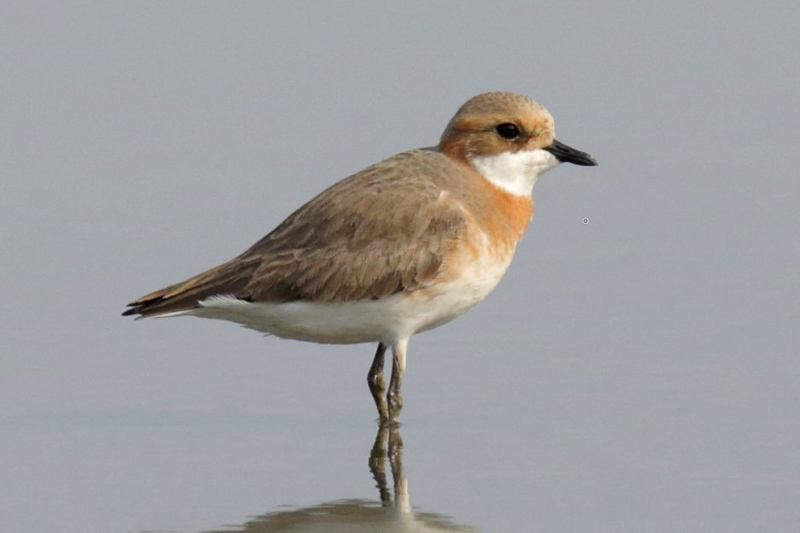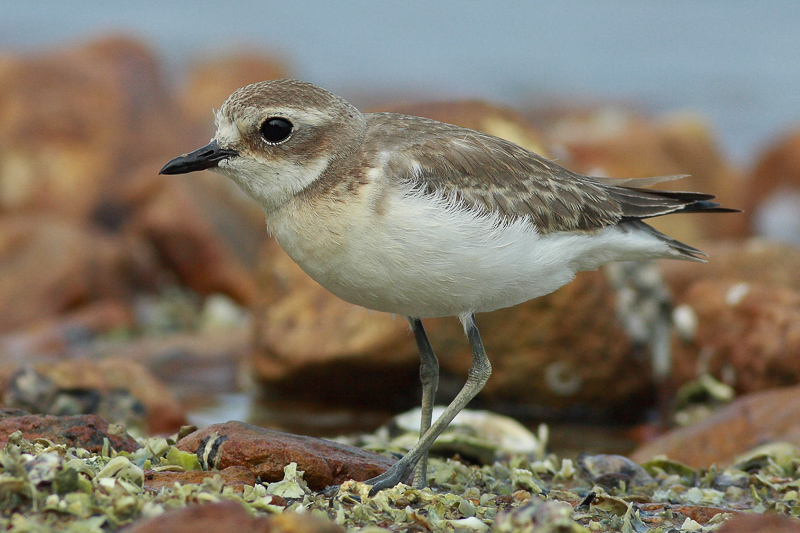Tibetan Sand Plover Charadrius atrifrons 青藏沙鴴
Category I. Scarce winter visitor and passage migrant in spring and autumn, mainly on intertidal mudflats in Deep Bay.
IDENTIFICATION

Aug. 2021, Sarawak, Malaysia. Dave Bakewell. Tibetan Sand Plover (left) and Greater Sand Plover (right).
Independent of plumage and taxon, distinguished from Greater Sand Plover firstly by structure: Tibetan Sand Plover is smaller with neater proportions, a less deeply-based bill that has a less swollen distal half and stubbier tip, a smaller eye and shorter legs. Secondly, most birds have greyish legs and darker upperparts (especially in spring) (Bakewell 2022). Finally, foraging behaviour also different: Tibetan Sand Plover has a more regular ‘stop-start’ foraging motion.

Nov. 2021, Sarawak, Malaysia. Dave Bakewell. Tibetan Sand Plover (left), Siberian Sand Plover (right).
Separation of Tibetan and Siberian Sand Plovers is not straightforward. In general, Siberian has colder and darker brown upperparts and ear coverts (making the white forehead and throat more obvious), greyish mottling on the flanks (although this may be faint), more extensive breast patches that often meet in the centre, a thicker stubbier bill, a slightly bulkier and less elegant body and shorter more olive legs (Bakewell 2022).

Apr. 2014, John and Jemi Holmes. Female, breeding plumage.
Compared to Siberian Sand Plover breeding plumage adults are paler, more orange on the chest, have clean white flanks and, on males, a more extensively dark forehead. Females, as this appears to be, are paler on the chest (orange-buff replacing the cinnamon) and have ear coverts not noticeably darker than crown.

Oct. 2008, Fung Hon Shing. Juvenile.
Juvenile Tibetan has a pale forehead that blends into the brown crown, warmer coloured fringes to the coverts and scapulars, cleaner flanks, more buff on the underparts and smaller breast patches that do not meet in the chest centre and relatively longer legs and bill.
VOCALISATIONS
The typical flight call is a trilling note that is very similar to Greater Sand Plover, though occasionally it sounds slightly drier; care and experience is required to separate the two.
DISTRIBUTION & HABITAT PREFERENCE
Most records of ‘Lesser Sand Plover’ are from the intertidal mudflats of Deep Bay, adjacent roosting areas of Mai Po NR and, occasionally, drained commercial fish ponds, as well as other areas of intertidal mudflat off Lantau (primarily Shui Hau), Sha Tau Kok and inner Tolo Harbour at Ting Kok, and occasionally on outlying islands such as Po Toi. Although most of these records were probably of Siberian Sand Plover, it appears that the habitat preferences of Tibetan are very similar.
OCCURRENCE
Given the lack of knowledge regarding the identification of Tibetan and Siberian Sand Plovers in non-breeding plumage in particular, and the general scarcity of Tibetan Sand Plover throughout the year, there are few data regarding its occurrence in HK. It appears to be a scarce passage migrant in both spring and autumn and a scarce winter visitor. It is much less numerous than Siberian Sand Plover in spring, but the relative proportions at other times of year are unclear.
Vaughan and Jones (1913) referred to a species of sand plover as an accidental winter visitor, though it is not entirely clear which, as it was named ‘Great Sand-Plover Ochthodromus mongolus’. Dove and Goodhart (1955) stated that Lesser Sand Plover occurred on both passages but never in such numbers as Greater Sand Plover.
BEHAVIOUR, FORAGING & DIET
Unlike its congener Greater Sand Plover, Lesser Sand Plover does not favour crabs, instead targeting worms and other invertebrates. The foraging technique involves more constant movement over the mudflat, rather than the relatively long periods of waiting and dashing runs utilised by Greater Sand Plover.
RANGE & SYSTEMATICS
Tibetan Sand Plover breeds in high plateau areas north and east of the Himalayas as far as extreme southern Mongolia and west to the Pamirs, and comprises C. m. pamirensis, C. m. atrifrons and C. m. schaeferi. In China breeds in plateau areas in the western half of the country, migrates through eastern coastal areas and the Yangtze floodplain and winters along the south coast, including Hainan and Taiwan (Liu and Chen 2021).
CONSERVATION STATUS
IUCN: Least Concern. Population trend unknown.
Bakewell, D. N. (2022). Identification of Siberian Charadrius (mongolus) mongolus and Tibetan C. (m.) atrifrons Sand Plovers. BirdingAsia 38 (2022): 23-36.
Dove, R. S. and H. J. Goodhart. (1955). Field observations from the Colony of Hong Kong. Ibis 97: 311-340.
Vaughan, R. E. and K. H. Jones. (1913). The birds of Hong Kong, Macao and the West River or Si Kiang in South-East China, with special reference to their nidification and seasonal movements. Ibis 1913: 17-76, 163-201, 351-384.
Liu, Y. and S. H. Chen (eds) (2021). The CNG Field Guide to the Birds of China (in Chinese). Hunan Science and Technology Publication House, Changsha.

